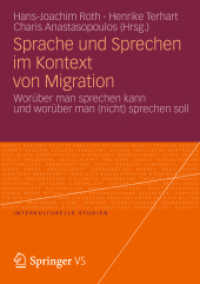Full Description
Spatial reasoning and planning is a core constituent in robotics, graphics, computer-aided design, and geographic information systems.
After a review of previous work in the related areas, Liu and Daneshmend present here a unified framework for qualitative spatial representation and reasoning, which enables the generation of solutions to spatial problems where the geometric knowledge is imprecise. The approach utilizes qualitative spatial representation and reasoning integrated with a quantitative search procedure based on simulated annealing. Many graphical illustrations and detailed algorithm descriptions help the readers to comprehend the solution paths and to develop their own applications.
The book is written as a self-contained text for researchers and graduate students in computer science and related engineering disciplines. The methodologies, algorithmic details, and case studies presented can be used as course material as well as a convenient reference.
Contents
1 Introduction.- 1.1 Motivation.- 1.2 Issues.- 1.3 Scope of the Book.- 1.4 Organization of the Book.- 2 Overview of Spatial Reasoning and Planning Techniques.- 2.1 Computer-Aided Kinematic Design of Mechanisms.- 2.2 Geometric Path Planning.- 2.2.1 Path Search in Configuration Space.- 2.3 Qualitative Reasoning.- 3 Interesting Problems in Spatial Reasoning and Planning.- 3.1 Terminology and Notation.- 3.2 The Problems.- 3.3 Assumptions.- 4 How to Represent Qualitative Spatial Relationships.- 4.1 Qualitative Distance.- 4.2 Qualitative Angle.- 4.3 Notes on Label-Based Distance and Angle Descriptions.- 4.4 Completeness.- 4.5 Minimum-Spanning Edge (m-Edge) between Two Polygons.- 4.6 Qualitative Location in a Convex Polygonal Environment.- 4.7 Graphic Representation of the m-Edge Partitioned Free-Space.- 4.8 Notes on Qualitative Location.- 5 Methodology of Spatial Reasoning and Planning.- 5.1 Spatial Inferencing.- 5.2 Envisionments.- 5.3 Spatial Planning in Q-Space.- 5.4 Quantitative Configuration Generation with Simulated Annealing.- 6 How to Reason about Mechanism Configurations.- 6.1 An Overview of the Method.- 6.2 Qualitative Configuration Analysis.- 6.3 Quantitative Configuration Generation.- 6.4 Discussions.- 6.6 Summary.- 7 How to Reason about Velocity Relationships.- 7.1 Instantaneous Rotation Center.- 7.2 Velocity Relationship Analysis.- 7.3 Examples.- 7.4 Notes on the Application of Velocity Analysis.- 7.5 Relative Motion Method of Analyzing Velocities.- 7.5.2 Kinematic Modeling.- 7.6 Qualitative Analysis of Relative Velocities.- 7.7 An Example.- 7.8 Summary.- 8 How to Plan Robot Motions.- 8.1 An Overview of the Method.- 8.2 Qualitative Route Planning in the m-Edge Partitioned Euclidean Free-Space.- 8.3 Constructing Exact Paths from Qualitative Routes.- 8.4 GraphicalSimulations.- 9 How to Make Spatial Measurements and Maps.- 9.1 Mapping.- 9.2 m-Uncertainty and FS Theory.- 9.3 Incorporating m-Uncertainty.- 9.4 Collective Spatial Map Construction.- 9.5 Self-Organization of a Potential Map.- 9.6 Experiments.- 9.7 Summary.- 10 Concluding Remarks.- 10.1 Key Concepts Revisited.- 10.2 Practical Application.- 10.3 Limitations.- 10.4 Future Challenges.- Appendices.- B The Boltzmann Distribution in Simulated Annealing.- C Qualitative Route Search Based on A. Algorithm.- References.







